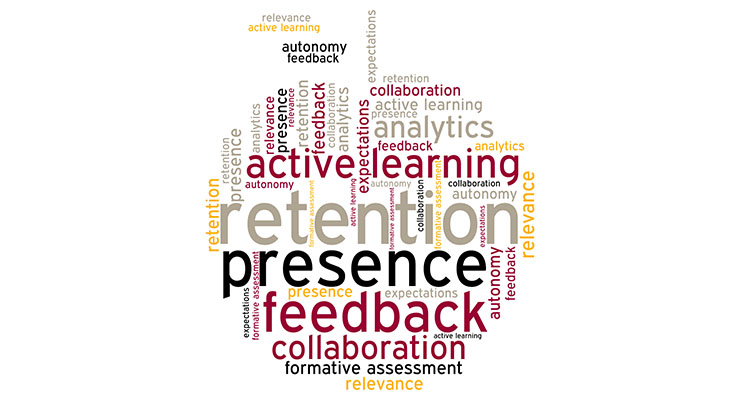9 Proven Ways for Instructors to Address Online Student Retention
With accessibility to online education increasing, the retention of online students has become a concern of academic leaders in higher education (Allen & Seaman, 2015). As a result, many universities have launched initiatives to improve course completion, program completion, and student support services (Johnson, Adams Becker, Estrada, & Freeman, 2015). Although many causes for students withdrawing from an online course are beyond the realm of instructor control, retention and attrition can be reduced through various means.
In the field of education, retention rate is generally defined as “the percentage of … students who continue in a program” (FASFA.gov), while attrition rate measures the decrease in enrollment during a course of study (Martinez, 2003). Although the reasons for students withdrawing from a course are varied, Ni, Diomede and Rutland (2013) point out that they are not always negative. For example, students might withdraw from a course because they “exercise control over … [their] learning path” (p. 102). Other factors for students withdrawing might be as simple as a cap on tuition reimbursement or time limitations (Boston, Ice, & Gibson, 2011).
Nevertheless, educators do not like to see students withdraw from courses for the wrong reasons. The following list includes proven strategies that can be implemented on a course level and are based on good principles for teaching (Chickering & Gamson, 1987), adult-learning strategies, and technology solutions:
- Be present – Instructor presence is key. Make early contact at the start of the class and stay active throughout the course (e.g, in discussion forums). Stay present by sending regular announcements and offering synchronous office hours. Explore additional tips for Instructor Presence at ASU TeachOnline.
- Encourage Active Learning – Active Learning requires students to engage with the course material through reading, writing, talking, listening, and reflecting (UMN, 2015). Incorporate activities that require students to move from passive consumers to active users of information. Check out these resources on Active Learning.
- Set clear expectations – Expectations help students gauge requirements for the course and individual assignments (e.g., rubrics). Make sure to keep expectations realistic to avoid student resignation. Scaffold learning experience so that high expectations are achievable.
- Provide constructive, meaningful and timely feedback – Feedback gives students an indication about their performance. Effective feedback is frequent, prompt, specific, and written in a supportive tone. Check out these helpful Feedback Strategies for the Online Classroom (Faculty Focus).
- Make course content relevant – Students might not immediately recognize the relevance of course content to their lives. Invite guest speakers to provide career specific examples or include “real world” examples to illustrate course content. Design assignments to be flexible and allow students to pursue interests.
- Included collaboration & peer-to-peer communication – A common criticism of online courses is the lack of interaction with peers. Offer opportunities for students to share perspectives, experiences, and learning. Communication can be informal (e.g., open topic discussion forum) or formal (e.g., group assignment, weekly discussion, wikis, blogs).
- Guide students to be autonomous – Self-directed learning describes students who take initiative and responsible for their own learning. However, not everybody has developed the skills to select, manage, and assess their own learning. Provide guidance by have student set goals or become aware of Metacognitive Skills (Faculty Focus).
- Collect formative feedback on lesson effectiveness & student comprehension – The decision to review a certain concept or continue often depends on whether students “get it” or not. Use an informal mid-semester survey and incorporate quick, easy-to-use, and non-graded assessment techniques. Check out these resources about formative Classroom Assessment Techniques (Angelo & Cross, 1988).
- Identify & reach out to struggling students – Similar to how technology allows us to count our daily steps or burned calories, many Learning Management Systems (LMS) now offer analytics to track student activities (e.g., last time logged in, submission date & time). Create an early alert system and reach out to students when necessary. Such tools allow instructors to offer support, share available resources to help student get back on track, or communicate with advising. Keep FERPA requirements in mind, though!
Do you have a proven way to engage and retain students you would like to share? Please comment.
References
- Allen, I., & Seaman, J. (2015). Grade level: Tracking online education in the United States. Babson Survey Research Group.
- Cross, K. P., & Angelo, T. A. (1988). Classroom assessment techniques. A handbook for faculty.
- Boston, W. E., Ice, P., & Gibson, A. M. (2011). Comprehensive assessment of student retention in online learning environments. Online Journal of Distance Learning Administration, 14(1).
- Chickering, A. W., & Gamson, Z. F. (1987). Seven principles for good practice in undergraduate education. AAHE bulletin, 3, 7.
- Infande, A. (2013). A dozen strategies for improving online student retention. Retrieved from Faculty Focus.
- Johnson, L., Adams Becker, S., Estrada, V., and Freeman, A. (2015). NMC Horizon Report: 2015 Higher Education Edition. Austin, Texas: The New Media Consortium.
- Kelly, R. (2013). Instructor strategies to improve online student retention. Retrieved from Faculty Focus.
- Martinez, M. (2003). High attrition rate in e-learning: challenges, predictors, and solutions. The eLearning Developers Journal.
- Ni, X., Diomede, S., & Rutland, S. R. (2013). Effects of using the quality matters (QM) programme as an intervention for online education. International Journal of Social Media and Interactive Learning Environments, 1(1), 93-105.
- University of Minnesota (2015). What is active learning? Center for Educational Innovation.
co-written by Peter van Leusen, Irma Sandercock, and Kody Stimpson



